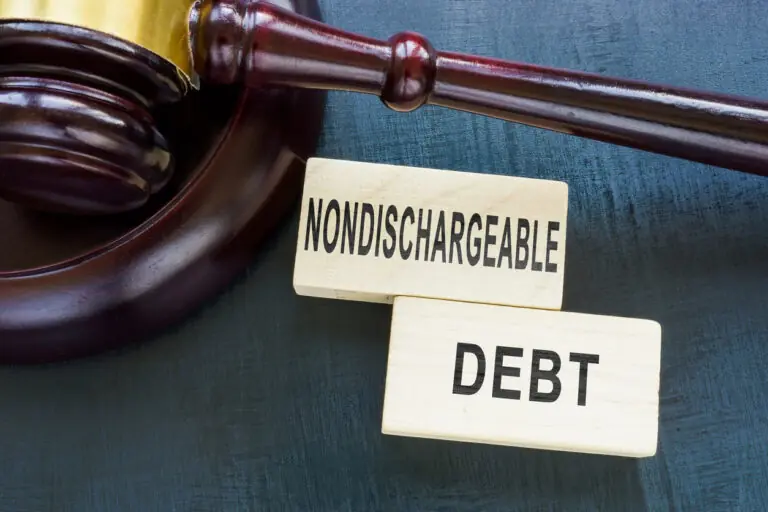On this page
What's next
Earn a high-yield savings rate with JG Wentworth Debt Relief
When facing overwhelming financial challenges, many Americans turn to bankruptcy as a way to get a fresh start. However, not all debts can be eliminated through bankruptcy proceedings. These obligations, known as non-dischargeable debts, can persist even after bankruptcy, affecting consumers’ financial recovery and future prospects.
If you need to know what non-dischargeable debts are, which debts typically fall into this category, and how they impact regular consumers in various situations, read on…
Non-dischargeable debts (in a nutshell)
Non-dischargeable debts are financial obligations that cannot be eliminated through bankruptcy proceedings. While bankruptcy typically provides relief from many types of debt, certain obligations are protected by law and remain enforceable even after a bankruptcy discharge has been granted.
These special categories of debt are generally considered to have higher social importance or involve circumstances where allowing discharge would be contrary to public policy. Understanding which debts remain after bankruptcy is crucial for consumers considering this option for financial relief.
1. Student loans
Perhaps the most well-known category of non-dischargeable debt is student loans. In most cases, student loans—whether federal or private—cannot be discharged in bankruptcy unless the borrower can prove “undue hardship,” a standard that is notoriously difficult to meet.
To demonstrate undue hardship, borrowers typically need to prove:
- They cannot maintain a minimal standard of living while repaying the loans.
- Their financial situation is likely to persist for much of the repayment period.
- They have made good-faith efforts to repay the loans.
In practice, very few borrowers succeed in discharging student loans through bankruptcy, though recent court decisions have occasionally shown more leniency in certain extreme cases.
2. Child support and alimony
Domestic support obligations, including child support and alimony (spousal support), are universally non-dischargeable in bankruptcy. The reasoning is straightforward: these obligations represent essential support for dependents and former spouses, and public policy strongly favors ensuring that these responsibilities are fulfilled.
Even bankruptcy filing fees associated with attempting to discharge these obligations are generally non-dischargeable.
3. Certain tax debts
Many tax obligations survive bankruptcy, though the rules are complex and depend on several factors:
- Income taxes may be dischargeable if they meet specific criteria, including being at least three years old, filed at least two years before bankruptcy, and assessed at least 240 days before filing.
- Trust fund taxes (like payroll taxes) are generally never dischargeable.
- Property taxes less than one year old are typically non-dischargeable.
- Tax liens often remain enforceable against property even if the underlying tax debt is discharged.
The complexity of tax debt dischargeability means consumers should consult with a tax professional or bankruptcy attorney to understand their specific situation.
4. Debts from fraud or misrepresentation
Debts obtained through fraud, false pretenses, or false representations are typically non-dischargeable. This includes:
- Credit card charges for luxury goods exceeding $800 made within 90 days of filing bankruptcy.
- Cash advances exceeding $1,100 taken within 70 days of filing.
- Debts where the consumer provided false information on a loan application.
- Debts arising from embezzlement, larceny, or breach of fiduciary duty.
Courts examine the circumstances surrounding these debts to determine whether they were incurred fraudulently and thus should survive bankruptcy.
5. Government fines and penalties
Most fines, penalties, and restitution ordered by government entities as punishment for violating laws remain enforceable after bankruptcy. These include:
- Criminal fines and restitution.
- Civil penalties for violations of federal or state laws.
- Traffic tickets and court costs.
- Penalties for tax fraud or evasion.
The non-dischargeability of these obligations reflects the principle that wrongdoers should not escape accountability through bankruptcy.
6. Debts not listed in bankruptcy filings
Debts that are not properly listed in bankruptcy paperwork may remain non-dischargeable simply because the court and creditors were not notified of their existence. This underscores the importance of comprehensive financial disclosure during the bankruptcy process.
Take your next step towards being debt-free
"*" indicates required fields
How non-dischargeable debts affect consumers
Now that you know which debts are non-dischargeable, how can they impact your finances?
During and after bankruptcy
During bankruptcy proceedings, non-dischargeable debts are treated differently than other obligations. In Chapter 13 bankruptcy, these debts must generally be paid in full through the repayment plan or they will remain due after the bankruptcy concludes.
After bankruptcy discharge, creditors holding non-dischargeable debts can resume collection activities, including:
- Wage garnishment (subject to legal limits).
- Bank account levies.
- Property liens.
- Regular billing and collection calls.
This can significantly hamper a consumer’s fresh start, as disposable income that could be used to rebuild finances must instead go toward paying persistent debts.
Financial planning implications
The existence of non-dischargeable debts changes the calculus of bankruptcy for many consumers. Someone with primarily dischargeable debts might benefit greatly from bankruptcy, while a person whose financial struggles stem mostly from student loans, recent taxes, or support obligations might gain little relief.
This reality requires careful financial planning, including:
- Prioritizing non-dischargeable debts when developing repayment strategies.
- Exploring alternative relief programs for specific debts (like income-driven repayment for student loans).
- Building emergency funds to prevent new debt while managing persistent obligations.
- Seeking legal advice to determine which debts might be dischargeable under specific circumstances.
Exceptions and special circumstances
While the general categories of non-dischargeable debt remain consistent, there are important exceptions and special circumstances that consumers should know about:
Hardship provisions
Some non-dischargeable debts have hardship provisions that allow discharge in extreme circumstances:
- Student loans can be discharged with proof of undue hardship.
- Tax debts may become dischargeable after certain time periods pass.
- Some pension-related obligations may be modified in cases of severe financial distress.
These exceptions are generally narrow, but they provide potential relief in particularly difficult situations.
Chapter 13 vs. Chapter 7 differences
The type of bankruptcy filed can affect which debts remain after discharge:
- Chapter 13 bankruptcy allows discharge of certain debts that would be non-dischargeable in Chapter 7, including some property settlement obligations in divorce.
- Debts arising from willful and malicious injury might be treated differently between chapters.
- Chapter 13’s “super discharge” provisions were significantly limited by the 2005 bankruptcy reforms but still offer some advantages for certain types of debt.
Understanding these differences is crucial when deciding which bankruptcy chapter to pursue.
Strategies for managing non-dischargeable debts
Consumers facing non-dischargeable debts have several strategies available to manage these obligations effectively:
Payment plans and settlements
Many creditors holding non-dischargeable debts will work with consumers on reasonable payment plans or settlements, especially after bankruptcy eliminates competition from other creditors. Options include:
- Income-driven repayment plans for federal student loans.
- Installment agreements for tax debts.
- Negotiated settlements for certain penalties and fines.
- Modified payment schedules for support obligations (though these typically require court approval).
Proactively approaching creditors often yields better terms than waiting for collection actions.
Rehabilitation programs
Some types of non-dischargeable debt have formal rehabilitation programs:
- Defaulted federal student loans can be rehabilitated through nine consecutive, reasonable, and affordable monthly payments.
- Certain tax obligations can be resolved through offer-in-compromise programs.
- Some court-ordered obligations may have compliance programs that reduce financial penalties.
These programs can improve terms and sometimes remove negative information from credit reports.
Legal remedies and appeals
In some cases, consumers may have legal remedies available:
- Requesting hardship discharge hearings for student loans.
- Appealing tax assessments or penalties.
- Seeking modification of support obligations due to changed circumstances.
- Contesting the classification of debts as having been incurred fraudulently.
While success is not guaranteed, these approaches can sometimes provide relief from otherwise non-dischargeable obligations.
The bottom line
Non-dischargeable debts represent a significant challenge for consumers seeking financial relief through bankruptcy. By understanding which obligations survive bankruptcy, consumers can make more informed decisions about their financial future.
For many, the best approach combines targeted legal strategies for addressing specific non-dischargeable debts with comprehensive financial planning that acknowledges these persistent obligations. With proper guidance and planning, even consumers facing substantial non-dischargeable debts can gradually rebuild their financial health and security.
There’s always JG Wentworth…
If you have $10,000 or more in unsecured debt there’s a good chance you’ll qualify for the JG Wentworth Debt Relief Program.* Some of our program perks include:
- One monthly program payment
- We negotiate on your behalf
- Average debt resolution in as little as 48-60 months
- We only get paid when we settle your debt
If you think you qualify for our program, give us a call today so we can go over the best options for your specific financial needs. Why go it alone when you can have a dedicated team on your side?
About the author
Recommended reading for you
* Program length varies depending on individual situation. Programs are between 24 and 60 months in length. Clients who are able to stay with the program and get all their debt settled realize approximate savings of 43% before our 25% program fee. This is a Debt resolution program provided by JGW Debt Settlement, LLC (“JGW” of “Us”)). JGW offers this program in the following states: AL, AK, AZ, AR, CA, CO, FL, ID, IN, IA, KY, LA, MD, MA, MI, MS, MO, MT, NE, NM, NV, NY, NC, OK, PA, SD, TN, TX, UT, VA, DC, and WI. If a consumer residing in CT, GA, HI, IL, KS, ME, NH, NJ, OH, RI, SC and VT contacts Us we may connect them with a law firm that provides debt resolution services in their state. JGW is licensed/registered to provide debt resolution services in states where licensing/registration is required.
Debt resolution program results will vary by individual situation. As such, debt resolution services are not appropriate for everyone. Not all debts are eligible for enrollment. Not all individuals who enroll complete our program for various reasons, including their ability to save sufficient funds. Savings resulting from successful negotiations may result in tax consequences, please consult with a tax professional regarding these consequences. The use of the debt settlement services and the failure to make payments to creditors: (1) Will likely adversely affect your creditworthiness (credit rating/credit score) and make it harder to obtain credit; (2) May result in your being subject to collections or being sued by creditors or debt collectors; and (3) May increase the amount of money you owe due to the accrual of fees and interest by creditors or debt collectors. Failure to pay your monthly bills in a timely manner will result in increased balances and will harm your credit rating. Not all creditors will agree to reduce principal balance, and they may pursue collection, including lawsuits. JGW’s fees are calculated based on a percentage of the debt enrolled in the program. Read and understand the program agreement prior to enrollment.
This information is provided for educational and informational purposes only. Such information or materials do not constitute and are not intended to provide legal, accounting, or tax advice and should not be relied on in that respect. We suggest that you consult an attorney, accountant, and/or financial advisor to answer any financial or legal questions.







